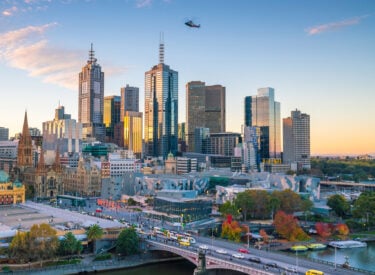
Key takeaways
Compound growth is the power of growth upon growth. If you take a single cent and double it every day, by day 30 you would have $5,368,709.12.
Exponential growth and the story of the lily pond. If a water lily planted in a pond doubles every month, it will take four years to cover 12.5% of the pond's surface, and another month to cover one-quarter, and so on.
The true cost of procrastination depends on the size of our "opportunity window", which can vary vastly depending on your age. For example, a 50-year-old couple bought their first home for $200,000 in 2000 and eight years later purchased their first investment property for $400,000.
When it comes to investment, we’ve all heard about the concept of compound growth.
It’s the powerful snowballing effect caused by growth upon growth.
It’s the ability for money to grow in value by ever-increasing multiples of itself, which, over time continually gets larger and larger.
Thanks to the power of compound interest, for example, if you took a single cent and doubled it every day, by day 30 you would have $5,368,709.12.
It seems too good to be true, right?
Let me give you another, more visual, example.

Exponential growth and the story of the lily pond
Let’s imagine that a water lily planted in a pond will double every month.
So after being planted on day one, by month two, there are two water lilies, by month three there are four, by month four there are eight… and so on.
Now it’s a big pond so let’s assume it will take four years (or 48 months) to cover 12.5% of the pond's surface.
It would then take another month for there to be enough water lilies to cover one-quarter of the pond, then just two more months until the pond is full.
That’s 51 months in total.
It’s important to note how quickly the process speeds up.
The same amount of lily plants grew in the 51st month as they did for the other 50 months combined.
Is compound growth amazing?
The problem is, this compounding effect has an enemy.
Procrastination: The enemy of compound growth
Procrastination is the financial enemy number one.
And when it comes to compound growth, it’s destructive.
Procrastination is postponing a task until tomorrow that could, or should, be done today.
It’s common self-sabotaging behaviour, and those who do it often use excuses to try to justify an unnecessary delay that will prevent them from reaching their goal.
Sometimes, they intentionally put obstacles in their path or choose a path that they know won’t lead to a good outcome.
Maybe it’s due to a fear of failure or disappointing others.
Maybe it’s simple laziness.
Either way, when it comes to investment, procrastination can cost you dearly.
The true cost of procrastination
Let's go back to the story of the lily pond for this one.
Imagine procrastination means you delayed planting that first water lily by just one month.
How much would that cost?
There are two answers here:
- One month later you would have 2 lilies instead of four
- It would take 52 months to fill the pond with water lilies, rather than 51 months
Either way, the opportunity cost is significant and it's clear that procrastination greatly impacts decisions and their outcomes.
But exactly the value of that cost depends on the size of our “opportunity window”.
We all possess an investment time window - this being the number of years that we can actively invest - which can vary vastly depending on your age.

Example one: 50-year-old Bob and Mary
Bob and Mary, a 50-year-old couple, bought their first home for $200,000 in 2000 and eight years later, in 2008, purchased their first investment property for $400,000.
They continue investing in real estate every second year, adding four more properties to their portfolio until 2016 at prices ranging from $400,000 to $670,000.
To many people, this may seem aggressive or unrealistic; however, to most of us with at least a few investments already, it is a very conservative and achievable goal.
In 2028, Bob and Mary will turn 70.
In that year alone, 20 years after buying their first investment property, assuming they’ve invested smartly and achieved a 9% annual growth or a doubling cycle of 8 years, their total portfolio value will grow from $12,162,882 to $13,257,541.
That is an annual wealth increase of $1,094,659 in just one single year.
In 2028, as a 70-year-old couple with five investment properties, they will have increased their daily income by $3,007, or $21,051 per week.
Assuming a standard 38-hour work week, they ‘passively earned’ the equivalent of $553 an hour, and were not paid any tax on this growth.
But… had Bob & Mary waited just one additional year to buy their first investment property (buying their first investment in 2009 rather than 2008), the opportunity cost to them in 2028 would have totalled $1.1 million.
Now let’s look at it another way and see how much the cost of procrastination and not starting to invest until they were 50 really cost Bob and Mary.
Example two: 22-year-old Mark and Jane
Mark and Jane, a 22-year-old couple, bought their first home for $200,000 in 2000 and eight years later, at age 30, they bought their first investment property for $400,000.
They then, like Bob and Mary, went on to invest another four more times over an eight-year period.
Assuming the purchase prices are the same, and those properties also enjoy the same 9% annual growth or a doubling cycle of 8 years, this couple would have enjoyed an extra 20 years of compound growth before reaching age 70 compared to Bob and Mary who started investing later in life.
Mark and Jane’s total property portfolio increase in its 40th year is now $6,134,921.
Assuming a standard 38-hour work week, they ‘passively earned’ the equivalent of $3,104 an hour – while that was Bob and Mary’s income in a day because they procrastinated and waited till later in life to invest.
A word of advice for investors: Don’t procrastinate.
Every day that an investor delays taking the next step of their investment journey shortens their investment opportunity window and potentially costs a significant sum.
The irony is that many people mean to get started, or take their next step, but get caught up busily earning $25 an hour… and so put off or procrastinate from taking the simple steps that could be worth $553 an hour (or more) at the back end, 20 years from now.
Buying property as soon as you can comfortably afford it means you will not waste your only investment window.
Because remember that your investment window is gradually closing - if you let your window close by just one more year you could lose as much as $1.1 million in compound growth, or perhaps even more.
How to overcome procrastination
It’s all very well me advising against falling victim to procrastination, but some of us are already in the downward spiral.
So, if you’re already in the grips of delaying, here are a few tips to overcome it and get back on the path towards compounding growth.
It involves using two very powerful principles that foster productivity and perseverance instead of passivity and procrastination:

1. Break it down
No matter what you're trying to accomplish, whether it's writing a book, climbing a mountain, or painting a house, the key to achievement is your ability to break down the task into manageable pieces and knock them off one at a time.
Focus on accomplishing what's right in front of you at this moment and ignore what is off in the distance someplace.
When people start to look that far ahead, many automatically go into a negative mode so the key is to think about the short-term goal in mind.
2. Write it down
We know how important writing is to goal setting and the writing for beating procrastination is very similar.
Instead of focusing on the future, however, you write about the present, logging what you actually do with your time - in other words, you keep a diary of your activities.
And you'd be amazed by the distractions, detours, and downright wastes of time you engage in during the course of a day, all of which lead to procrastination of your goals.
It’s worth remembering though that these are powerful and effective productivity techniques.
This is how you put an end to procrastination.
This is how you get yourself started and put yourself on the right track to be able to achieve compound growth.

What does this mean for you?
If your finances allow you, consider buying your home or an investment property sooner rather than later.
In the medium term, our property markets will be underpinned by 3 factors:
- A significantly growing population
- Strong jobs creation
- Increasing the wealth of our nation.
I see the current market offering a window of opportunity for property investors with a long-term focus.
You see…we are at the early stages of a new property cycle, something that doesn’t happen very often.
Not that I suggest you try and time the market- this is just too difficult, and in truth, you’ve missed the bottom, which occurred in early 2023.
But if the market hands you an opportunity like this, why not take advantage of it?
Taking advantage of the upturn stage of a property has created significant wealth for investors in the past.
Moving forward, demand is going to outstrip supply for some time to come as we experience record levels of immigration at a time when we’re not building anywhere as many properties as we require.
At the same time, the cost of construction of delivering new dwellings will keep increasing not only because of supply chain issues and the lack of sufficient skilled labour but also because builders and developers will only commence new projects if they are financially viable and currently new projects will need to come on line at considerably higher prices than the current market price,
Of course, in due course, consumer sentiment will rebound when it becomes clear that inflation continues to fall and interest rates have peaked.
At that time pent-up demand will be released as greed (FOMO) overtakes fear (FOBE - Fear of buying early), as it always does as the property cycle moves on.
We are also going to be experiencing a prolonged period of strong rental growth - the rental crisis will only worsen further, with no end in sight.
Now I'm not suggesting taking advantage of tenants, what I'm suggesting is to recognise there is currently a problem (lack of rental accommodation) and provide a solution.
So rather than trying to hunt down a bargain, focus on buying an investment-grade property in an A-grade location because these types of properties are in short supply but are still selling for reasonably good prices… Plus, they’ll hold their value far better in the long term.
While it might feel counterintuitive to buy at a time when there are so many mixed messages in the media, you can benefit from less competition, low consumer sentiment, minimal downside risk and minimal risk of oversupply.
And you can take advantage of the power of compounding!














